Written by:
Last Updated:
Wedding traditions are a tapestry of cultures, histories, and deeply meaningful rituals.
One such tradition, ‘Jumping the Broom,’ weaves a story that spans continents and centuries. It is becoming a popular unity wedding ceremony tradition for couples looking for something meaningful and unique.
This ancient practice, whose origins are debated, resonates not only as a symbol of unity and new beginnings but also as a testament to resilience in the face of adversity.
Today, ‘Jumping the Broom’ has transcended its origins, finding a place in modern weddings around the world, where couples of diverse backgrounds embrace its symbolism to celebrate their love.
In this blog post, we delve into the history, cultural variations, and contemporary uses of this cherished wedding tradition, exploring how it continues to enrich ceremonies and symbolize the start of a beautiful journey together.
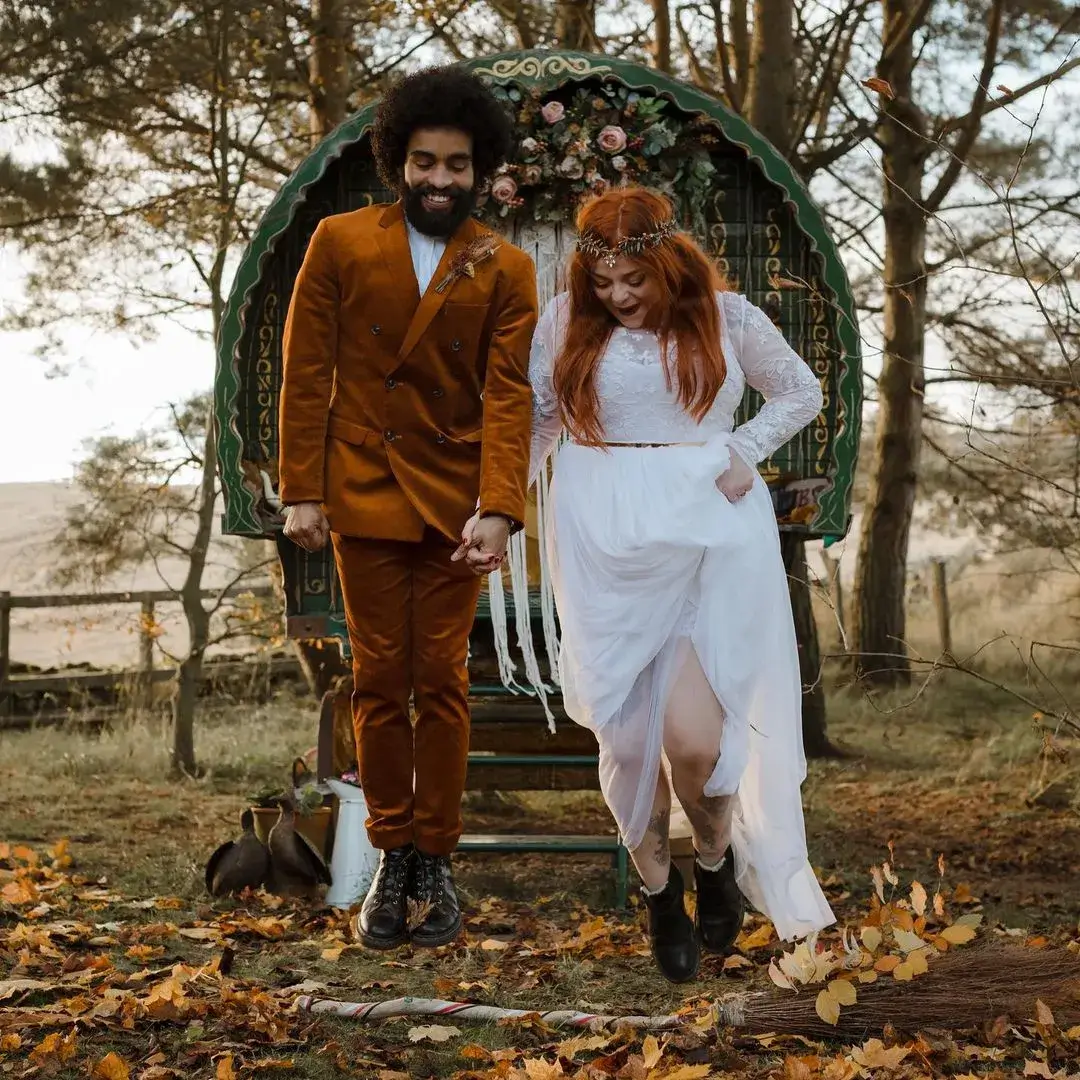
European History of jumping the broom
Jumping the broom is a wedding tradition with a rich history and diverse regional variations. One of the most notable variations of this tradition can be found among the Romani people in Wales, where it is known as a “Besom Wedding.”
In Wales, Romani couples faced a unique challenge: the church did not recognise their marriages. As a result, they developed their own way of solemnizing their unions through Besom Weddings. The term “Besom” refers to a type of broom, which played a central role in these ceremonies.
During a Besom Wedding, the couple would stand before a besom or broom, typically placed on the ground or at an angle by the doorway. To initiate their marriage, the couple would jump over the broom without touching it, symbolizing their commitment and the beginning of their life together as a married couple. This act served as a substitute for traditional church recognition.
Interestingly, the broom also played a role in annulment. If the couple wished to end their partnership, they would again jump over the broom, but this time, they would do it backwards. This act signified their marriage’s dissolution and their union’s end.
Historical records from as early as the 1700s in Wales provide documentation of this unique wedding ritual. The Romani couples in Wales, known as Welsh Kale, continued to practice the tradition of jumping the broom well into the 1900s. This custom also had variations in other parts of England and Wales. It has been linked to pagan weddings and traditions.
In some regions, the groom would jump over the broom first, followed by the bride, as they officially began their married life. In these areas, jumping over the broom was a significant ritual without legal contracts and church recognition.
While there is some debate about the origin of this tradition, with some attributing it to the Welsh people and others to the Romani community, what remains clear is that jumping the broom in Wales, whether as a priodas coes ysgub (besom wedding) or a Romani custom, reflects the cultural diversity and creativity of communities striving to celebrate their unions in the face of societal challenges and restrictions.
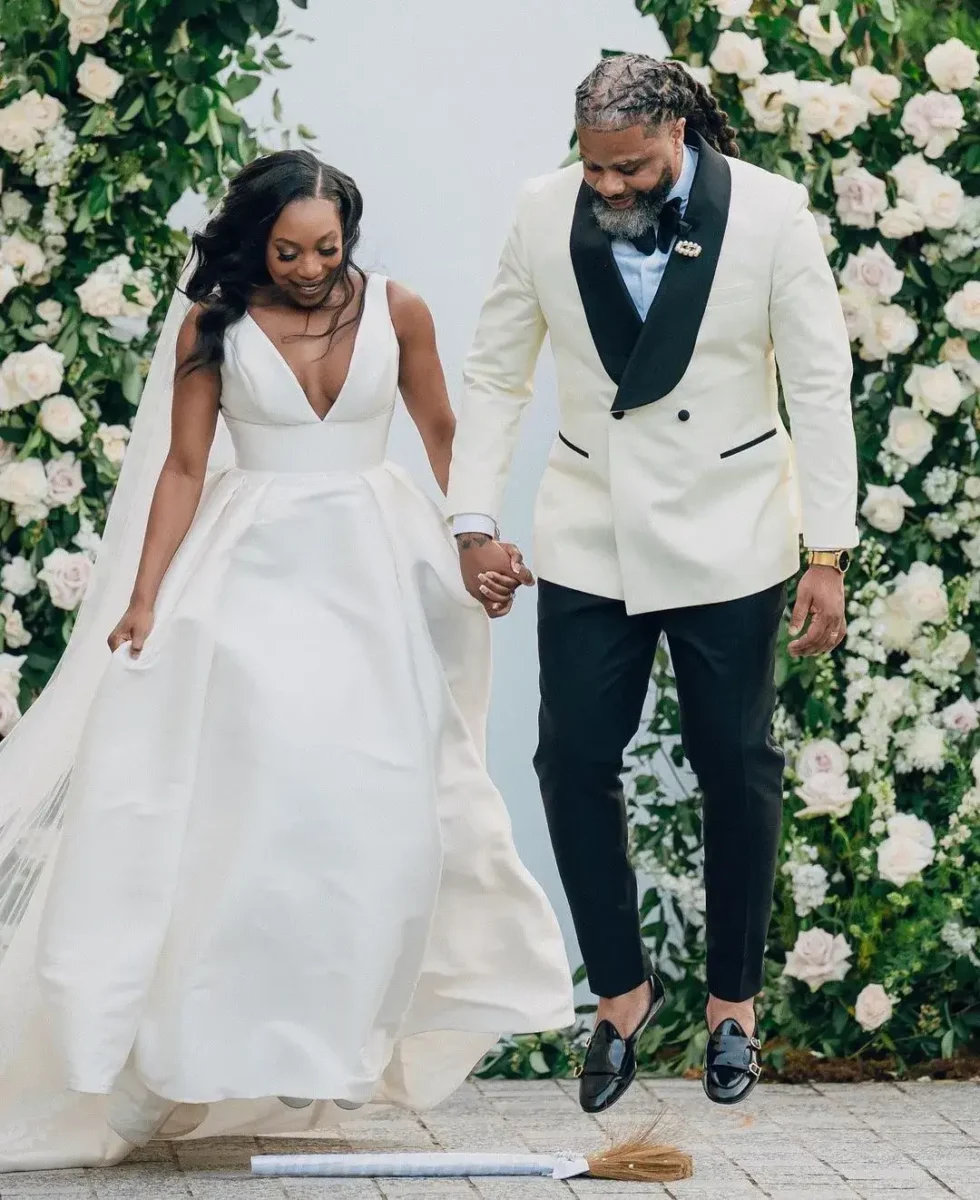
Afician amerian history of jumping the broom
The history of jumping the broom in the context of African American culture is a unique and important tradition that dates back to the time of slavery in the United States.
African Origins: Jumping the broom has its roots in African cultures, where it was practised by various ethnic groups across the continent. In different African societies, brooms and besoms were symbols of domesticity and were used in various rituals and ceremonies, including weddings. These ceremonies often had different variations, but they shared the common symbolism of sweeping away the past and starting anew.
Enslaved Africans in America: During the transatlantic slave trade, millions of Africans were forcibly brought to the Americas, including the United States. Enslaved Africans faced extreme hardship and oppression, and their marriages were not legally recognized by the American colonial and later U.S. governments. Slavery often tore families apart, and enslaved individuals were denied the legal right to marry in many cases.
In this challenging context, enslaved African Americans adapted and preserved their cultural traditions and rituals, including the practice of jumping the broom. They used this tradition as a way to formalize their unions and express their commitment to one another, even in the absence of legal recognition. Jumping the broom became a powerful symbol of resilience, unity, and hope for a better future.
Post-Emancipation and Beyond: After the abolition of slavery in the United States, African American couples continued to practice jumping the broom as a part of their wedding ceremonies. It served as a reminder of their cultural heritage and the strength of their communities.
In the 20th century, during the Civil Rights Movement and the African American cultural resurgence, there was a renewed interest in and celebration of African American traditions, including jumping the broom. This tradition gained broader recognition and acceptance as a symbol of African American cultural pride and resistance to oppression.
Today, jumping the broom is often incorporated into African American weddings as a way to honor their heritage and the struggles their ancestors faced. It has also gained popularity in broader American culture as a meaningful and symbolic wedding ritual.
In summary, jumping the broom in African American history represents a powerful cultural tradition that originated in Africa, was adapted and preserved during the dark days of slavery, and continues to be a cherished and meaningful part of African American wedding ceremonies, symbolizing love, commitment, and resilience.
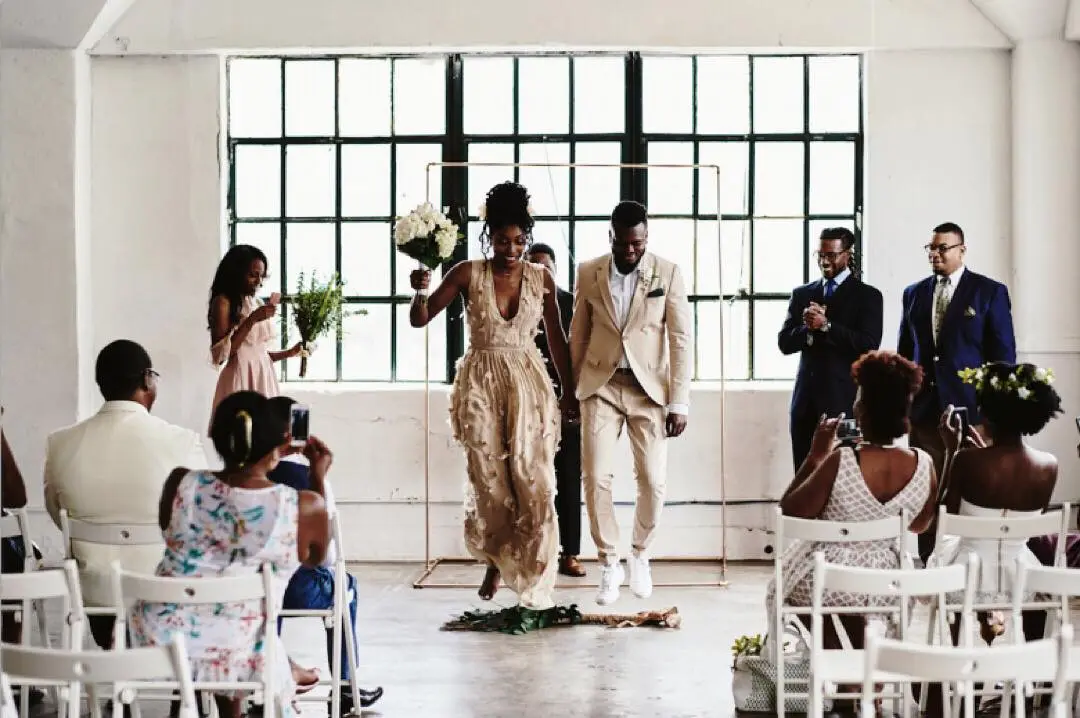
IMAGE: STEPHANIE ROGERS
Modern jumping the broom weddings
Jumping the broom has found a place in modern weddings across various cultures as a symbol of unity and new beginnings. In African American weddings, it remains a significant tradition where the couple jumps over a broom together, signifying their commitment.
In non-cultural and alternative weddings, couples may choose to incorporate jumping the broom to add a unique and meaningful touch to their ceremonies. Interfaith and interethnic weddings sometimes use this tradition to blend the customs of both partners.
It has become a popular choice with couples planning a pagan wedding ceremony. Moreover, as same-sex marriage has gained acceptance, this tradition has been adapted for LGBTQ+ weddings as a universal symbol of love and commitment.
In modern weddings, jumping the broom is a versatile and inclusive tradition that allows couples to honour their heritage, create memorable ceremonies, and symbolize their commitment in a meaningful way.
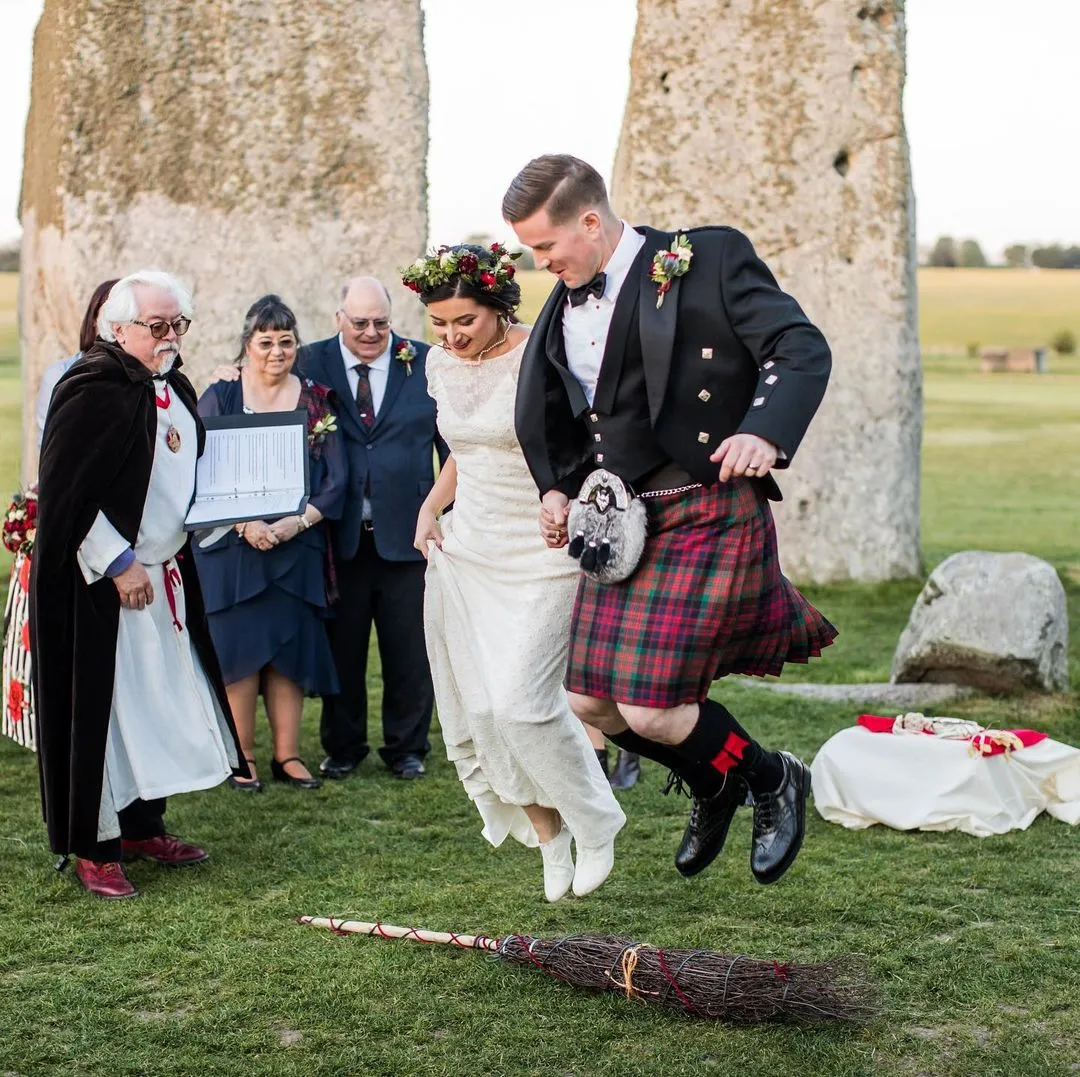
IMAGE: DARIO ENDARA
The broom used with jumping the broom ceremonies
The type of broom traditionally used for jumping the broom can vary depending on the cultural context and personal preferences.
In many cases, a simple household broom or a besom (a type of broom with a bundle of twigs or straw) is used.
However, some couples choose to use specially designed decorative brooms for their wedding ceremony.
If you are looking for something unique then making your own and getting creative is a great way to have something special and unique. If you are looking to buy then I would suggest heading to Etsy for lots of stunning options.
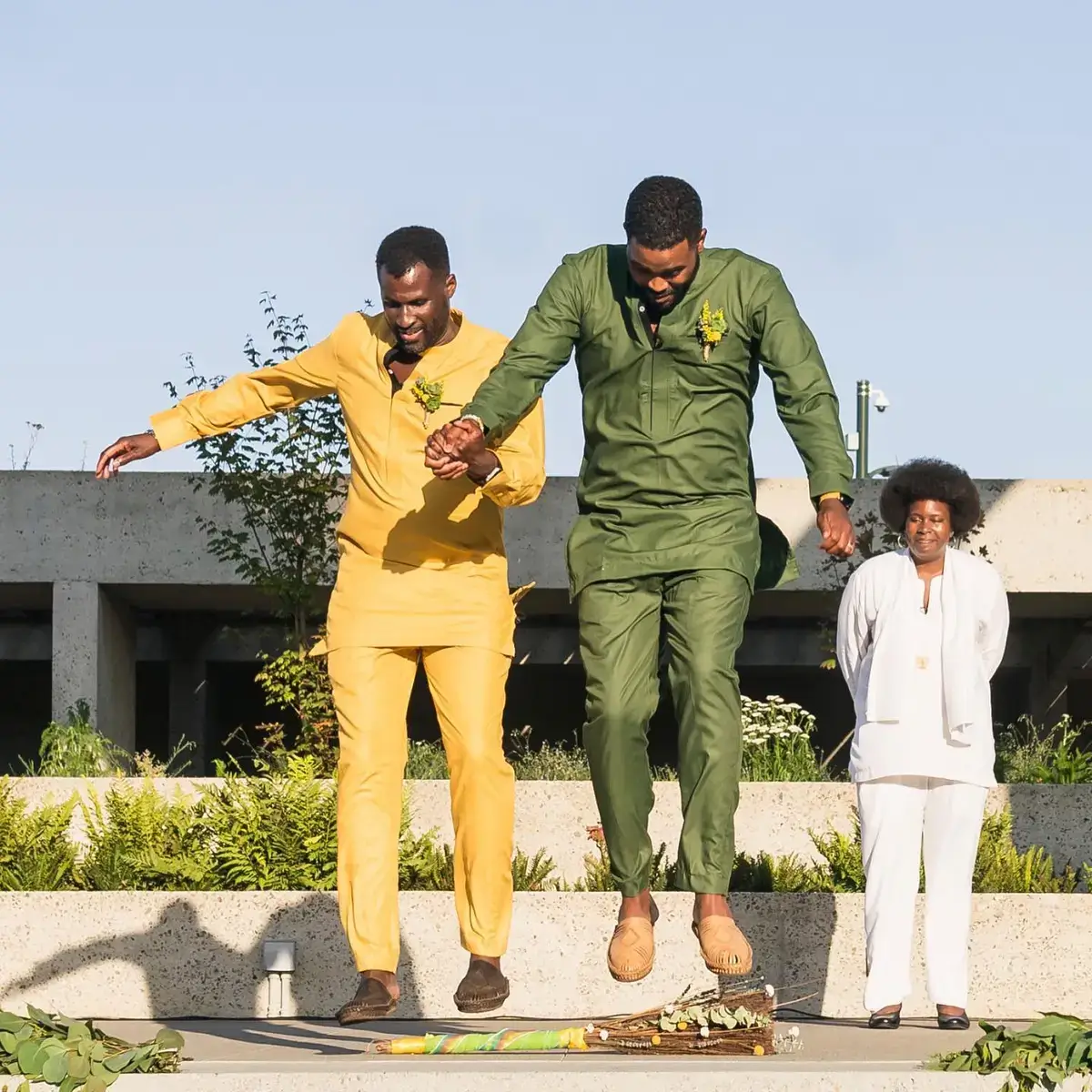
How to plan a jumping the broom ceremony
Research and Understand the Tradition
Begin by researching the history and significance of jumping the broom in the context of your culture or the culture you want to incorporate into your wedding. Understanding the tradition’s roots and symbolism will help you plan a ceremony that resonates with its historical significance.
Consult with an Officiant or Celebrant
If you have an officiant or celebrant presiding over your wedding, discuss your intention to include a jumping the broom ceremony. They can offer guidance and incorporate the tradition seamlessly into your overall ceremony.
Choose the Broom
Decide whether you want to use a traditional household broom, a besom, or a specially designed decorative broom. Ensure that the broom aligns with the style and aesthetics of your wedding.
Personalize the Broom
Consider decorating the broom to make it uniquely yours. You can add ribbons, flowers, or other decorative elements that match your wedding theme or colours. Some couples also engrave their names and wedding date on the broom’s handle.
Designate a Broom Holder
Choose someone, such as a close friend or family member, to hold the broom during the ceremony until it’s time to jump. This person can also present the broom to you and your partner when the time comes.
Incorporate the Ceremony
Decide where in your wedding ceremony the jumping the broom ritual will take place. It’s often performed near the end, just before the couple is pronounced married. Your officiant can introduce the tradition and its significance to your guests.
Exchange Vows or Words
Before jumping the broom, you may choose to exchange vows, express your love for each other, or share words of commitment. This can be a heartfelt moment to personalize the ceremony.
Jump the Broom
When the time comes, you and your partner should stand on one side of the broom, facing each other. Hold hands and, on the count of three, jump over the broom together. Be sure to coordinate this movement, as it symbolizes your commitment and the threshold of your new life together.
Acknowledgement and Celebration
After jumping the broom, you can celebrate with applause, cheers, or music. Consider having a meaningful song or music playing during this part of the ceremony to add to the atmosphere.
More blogs you will love!
- Forever Starts Here: Modern Date Tattoo Ideas for Wedding Memories
- Alternative Guest Book Ideas for a Unique Wedding
- Fun & Interactive Save the Date Ideas to Wow Your Guests
- Unique Save the Date Ideas Your Guests Will Actually love
- Nonreligious Wedding Reading Ideas: Celebrate Love Your Way
- Spiritual Wedding Ideas: Meaningful Rituals for a Deeply Personal Celebration

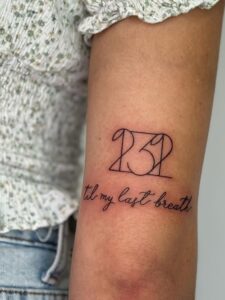






Very interesting blog
Thanks!
where can a celebrant learn this ceremony?
Nice article